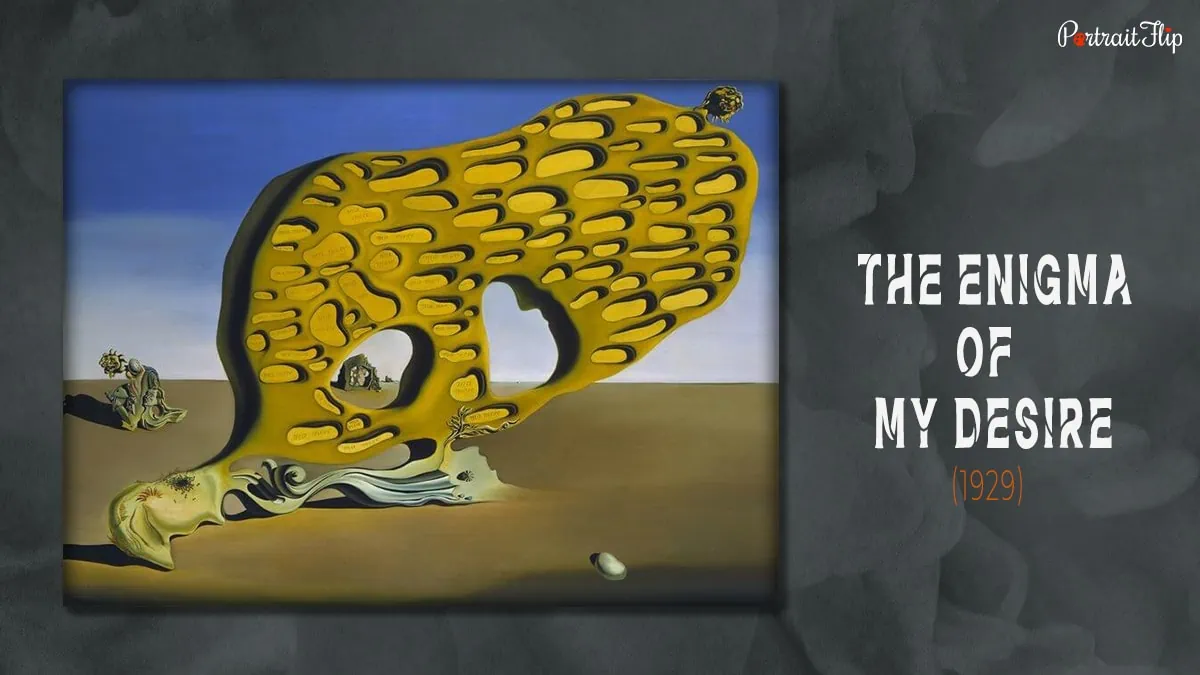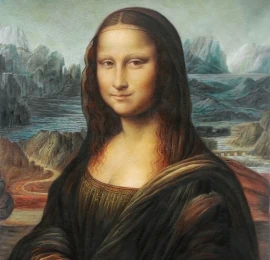“Drawing is the honesty of the art. There is no possibility of cheating. It is either good or bad”
– Salvador Dali
Salvador Dali (1904–1989), a Spanish Surrealist painter, printmaker, performance artist, and filmmaker, is renowned for his exploratory and subconscious paintings.
Born in Catalonia, Spain, he was the most versatile artist of the 20th century.
He was also one of the biggest contributors to the famous 20th-century movement, Surrealism movement.
Not only Dali, but many famous Cubist artists belong to the movement because of their incredible works.
Since 1929, Dali has created a large chunk of Surrealist works that are considered his hallucinations and inner conceptions.
He experimented with visual art and conceptualist styles as a painter.
Dali was often regarded as a wild artist of his time.
Here we’ll learn more about 16 famous artworks by Salvador Dali, with their history, fascinating stories, and achievements.
The aspects that made them famous and grabbed viewers’ attention!
Table of contents
- The Endless Enigma (1938)
- Dream Caused By The Flight Of A Bee (1944)
- The Ghost of Vermeer of Delft Which Can Be Used As a Table (1934)
- The Enigma of My Desire (1929)
- Portrait of Picasso (1947)
- The Face of War (1941)
- Spider of the Evening (1940)
- The Burning Giraffe (1937)
- Tuna Fishing (Homage to Meissonier, 1967)
- Galatea Of The Spheres (1952)
- Metamorphosis Of Narcissus (1937)
- Christ Of Saint John Of The Cross (1951)
- The Great Masturbator (1929)
- Soft Construction With Boiled Beans (1936)
- Swans Reflecting Elephants (1937)
- The Persistence Of Memory (1931)
- FAQs
16. The Endless Enigma (1938)

This piece is made up of many infinite elements and is by far Dali’s most intricate and dense painting.
The artist painted Endless Enigma while on vacation at the La Pausa estate.
This gave Dali the freedom he required to do extensive, large-scale research on the double images.
A large crowd had assembled to marvel at the visual depth of Salvador Dali’s new art of surrealism, which was on display at the 1939 exhibition.
Dali recreated the six various phases of the piece; each lightly sketched on tracing paper to emphasize his viewpoint.
The states represented the artistic thinking which was used to create a visual.
The artwork exhibits in the Kunst Palast museum that were not assigned a monetary value.
15. Dream Caused By The Flight Of A Bee (1944)

The name of the painting goes with the full title, “Dream Caused By The Flight Of A Bee a Pomegranate a Second Before Awakening.”
It portrays a sleeping, nude woman who was believed to be his wife, Gala.
She is lying next to a pomegranate as a sign of fertility, and a bee symbolizes a virgin.
A pomegranate explodes into a series of images, releasing a massive fish from which two deadly tigers emerge.
Further, a long gun is seen that will soon awaken Gala from her dreams.
But why is it so renowned?
The artwork of Salvador Dali from the post-Second World War era is renowned for portraying his belief in Freudian Sigmund analysis.
The Thyssen-Bornemisza Museum in Madrid, Spain, houses this artwork whose value ranges from 4 million to 22 million dollars.
14. The Ghost of Vermeer of Delft Which Can Be Used As a Table (1934)

This dark figure painting was inspired by the work “The Art of Painting” by a seventeenth-century famous painter, Johannes Vermeer.
Dali portrays Vermeer as a dark figure kneeling with extending legs on the tabletop bottle and glass set out for visitors.
Salvador Dali’s bizarre and amusing expansion of the man’s leg and showcasing his back is a definite surrealist touch.
The painstaking method that makes this tiny piece of art light from within is a beaming stroke.
This surrealist artwork is on exhibition at the Salvador Dali museum in Florida. However, the cost of it remained anonymous or undisclosed.
13. The Enigma of My Desire (1929)

The Enigma of My Desire is recognized as one of Dali’s top ten pieces of art.
With a fish, a grasshopper, a dagger, and a lion’s head, the young child on the left is Salvador himself, embracing his father.
The words “me mère” (my mother) are found in over half of the eighty-one compartments.
This was the first artwork by Salvador Dali that was sold by the Goemans Gallery during his first one-man exhibition.
Currently, this masterpiece is situated in the Metropolitan Museum of Art, New York.
The painting was created when surrealism was gaining support in France and earned a high bid of 16.3 million dollars.
This gave the painting an appearance of a masterpiece and establishing a value that speaks for itself.
12. Portrait of Picasso (1947)

Salvador Dali and Pablo Picasso were two renowned artists of their time.
There are numerous paintings by Pablo Picasso which made him famous but this portrait of Picasso by Dali changed the perspective towards art.
Despite having uncomfortable and unsettling visuals, this artwork by Salvador Dali conveys a different message.
Picasso’s long gray hair, extending from lips and ending in a spoon holding a miniature mandolin symbolizes life and leadership.
With Dali, bizarre visions aren’t always meant to be understood.
He once quoted “I do not paint a portrait to look like the subject; rather does the person grow to look like his portrait.”
The art lives in the Dali Theater and Museum in Spain and hasn’t been claimed with a specific price.
In addition to these two, many more surrealist artists made contributions to the surrealism movement.
11. The Face of War (1941)

Following the horrific Spanish war face, this Salvador Dali’s artwork was completed at the end of 1940.
With eyes filled with infinite human skeletons gives a chilly appearance to the viewer.
It is known among the most famous scary paintings ever!
The terror people experienced during the war could be seen through the snakes surrounded by faces.
It depicts the attack on innocent people during the war time.
Dali used surrealism to portray reality and build a face of suffering and the loss of people.
It gives the viewers a deadly look, which includes the situation people were in.
This lethal piece is owned by the Museum Boijmans Van Beuningen in Rotterdam, Netherlands.
It has also been auctioned multiple times for up to 2.3 million dollars.
The quote made by Salvador Dali, “Wars have never damaged anyone except the people who die” illustrate how destructive war was and how important peace is to human existence.
10. Spider of the Evening (1940)

The first title given to the painting was “Soft Cello, Spider, and Great Masturbator.”
Later, it was renamed by Salvador as “Evening Spider Promises Hope.”
This remarkable painting by Salvador Dali, took about a year (1939–1940) to complete.
It features the same dazzling sky and landscape background as other work from the 1940s, The Sublime Movement.
A winged cupid, symbol of love, sits crying in the bottom left corner and sorrows this entire melting scene.
A sensation of loss is evoked by long shadows, evocative evenings, and clinging to belongings.
The painting is exhibited at the Salvador Dali Museum, Saint Petersburg without a definite price tag.
Suggested Read: Famous Spanish Artists
9. The Burning Giraffe (1937)

The Burning Giraffe is viewed as a reflection of Salvador Dali’s internal conflict with the civil war raging in his home country, Spain.
Paintings of women have often been popular in culture.
This one depicts two women with undefined body shapes that are invasive from the back.
The characteristics are represented by the open drawer in a blue feminine figure, which Salvador later described as “Femme-coccyx,” the tailbone of a woman.
These aspects could be related to Sigmund Freud’s psychoanalytic theories, which Dali admires and depicts in his artwork.
Dali described the background as “the masculine cosmic apocalyptic monster,” with a belief that it was a wartime prophecy.
It was also showcased in the film L’ Age d ‘or the Golden Age, on which he collaborated with Luis Bunuel in 1930.
This artwork by Salvador Dali was displayed at the Fine Arts Museum, Kunstmuseum Basel, Switzerland, with a worth around $20,000 in today’s money.
8. Tuna Fishing (Homage to Meissonier, 1967)

One of the famous Salvador Dali’s final masterpiece, Tuna Fishing is his most well-known paintings.
Tuna Fishing depicts the discomfort between humans and large fishes; the artist has emphasized killing, which personifies the limited universe.
Dali later stated that he was attempting to demonstrate the concept of a finite rather than an infinite universe.
Apart from surrealism, he also embraced pointillism, action painting, tachisme, psychedelic art, and the pop art movement, which took him almost a year (1966-1967) to accomplish.
This painting of Salvador Dali was dedicated to Jean Louis, a French painter who is well known for his depictions of battle scenes.
As the artist’s final piece, the painting is housed in the Paul Ricard Foundation, which is a private art collection based in France, and is worth an astounding $2 million.
7. Galatea Of The Spheres (1952)

Galatea of the Spheres is an amazing artwork by Salvador Dali that fetched millions of dollars at auction, and is currently on display in the Dali Theatre-Museum.
Dali’s love for nuclear physics and its following the atomic bombings of Hiroshima and Nagasaki made him draw this painting.
Featuring his wife, Gala, as floating spheres, he showcased atomic particles rotating around the face of “Galatea,” with closed eyes and an emphasis on her mouth.
The atomic particles never coming into contact with one another represents the nuclear theory, while Galatea’s flowing hair gives the painting a sense of depth.
“Galatea of the Spheres” is a demonstration of how molecular formulas can be turned into pieces of art through the artistic reproduction of genetic code.
6. Metamorphosis Of Narcissus (1937)

“Metamorphosis” is the process of changing from an immature to an adult, which in some ways explains the title or transformation that Narcissus, a figure from Greek mythology, endures.
The piece of art is a reflection on the Greek story of Narcissus, a man of immense beauty who grew deeper in love with himself by shattering the hearts of others.
God punished him for this thought by forcing him to look at his own reflection in water, which he fell in love with but could not embrace, leaving him disappointed.
In this painting of Salvador Dali, a technique known as “hand-painted color photography” is used to depict the hand holding the egg from which the flower is emerging as a vision of God giving him eternal life as a Narcissus flower (a daffodil).
This first artwork of Salvador Dali exclusively used the paranoiac method, which he defined as “irrational knowledge” based on a “delirium of interpretation.”
The painting has set a record price at auction of $17 million and is currently housed at the Tate Modern Art Gallery in London.
5. Christ Of Saint John Of The Cross (1951)

Salvador Dali painted this precise work of art, which was inspired by Saint John of the Cross, after having it in his dream a year ago.
Salvador was able to create charcoal black oil paint to portray the body of Christ, which appeared as the centerpiece of the painting.
By blending the realistic colors and creating a surreal portrait of a holy figure, he was able to depict the shadows that gave the painting depth.
There are many famous paintings of Jesus, where this one ranks in the top ten.
This painting of Jesus is in the collection of the Kelvingrove Art Gallery and Museum, Glasgow, Scotland, and was purchased for less than ten thousand pounds but is now valued at 60 million.
4. The Great Masturbator (1929)

The painting was drawn by Dali when he was at the early stage of his relationship with Gala, who was still the spouse of a poet, Paul Eluard.
Through a female figure that appears with her head next to the male figure’s crotch while carrying numerous personifications of the artist’s anxieties about their relationship.
This artwork by Salvador Dali shows the manifestation of his hidden desires regarding romance and his fear of Gala taking advantage of him.
The grasshopper in this painting symbolizes Dali’s fear of insects and the idea of being swallowed up by or consumed by Gala.
This famous surrealist painting by Salvador Dali is currently on display at Madrid’s Museo Nacional Centro de Arte Reina Sofía, with the tag “never sold.”
3. Soft Construction With Boiled Beans (1936)

The painting is housed in the Philadelphia Museum of Art in the United States, depicts the horror of the Spanish Civil War.
It erupted six months after Salvador Dali completed it.
In 1934, Dali and his wife Gala were caught in a protest and a military action.
This gave rise to the idea to depict the Spanish Civil War that he claimed he knew would occur before it did.
Dali was disturbed and in grief when he learned about the execution of his friend and the detention and torture of his sister.
He was inspired by the event to create this piece of art in 1936, which depicts the tragedy by showing two monstrous creatures with two sections attached to one body, being destructive like the war itself.
Salvador Dali’s paintings are among the most striking representations of the unconscious mind; they are gruesome, weird, and extremely precise in technique, with a highly auctioned price of 16 million dollars.
2. Swans Reflecting Elephants (1937)

This artwork by Salvador Dali is from the paranoiac-critical period where in his earlier work, Metamorphosis of Narcissus, he used a double image for Narcissus as the shape of a hand holding an egg with a flower emerging out.
Here, he placed the three swans in front of the leafless trees, which, by reflection in the lake, the swans forefront create the shape of an elephant’s head and the trees as their bodies.
The artwork shows hallucination pattern, double images, and visual effects.
Swans Reflecting Elephants is currently in Dali’s private collection.
The last price was worth $3.5 million. Huge!
This piece of art, which Dali described as a “spontaneous way of irrational comprehension founded upon the interpretative critical association of delirious events,” was presented in his 1935 essay “The Conquest of the Irrational.”
1. The Persistence Of Memory (1931)

The Persistence of Memory is a famous Surrealist and Cubist landscape painting.
It depicts how change is the only constant and nothing remains the same as it was before.
The scenes with watches slowly melting on a rock or tree branch speak about the soft and hard realities of life.
It symbolize how time has power over humanity’s eternal existence.
The unconscious relativity of space and time, where ants surrounding the watches represent decay.
Do you know that Persistence of Memory also has another title attached to it?
Yes, its true. The painting is also known as melting clock painting.
This iconic painting is displayed in the Museum of Modern Art in New York City since 1934.
It’s worth is between $50 million and $150 million.
Among all the artworks by Salvador Dali, “The Persistence of Memory” is the most famous piece of the 20th century and the most renowned surrealist painting to date.
You can also read about some famous artworks by Leonardo: The Last Supper Painting or Mona Lisa
Hola Amigos!
Thank you for reading this article about the artworks by Salvador Dali and the narrative that each painting carries.
I hope you find the writing well-informed and learn something new from this reading.
If you have any additional information about the painting, please share your thoughts in the comment section below.
We will be happy to hear from you.
Explore our reproduction painting gallery to get your own original piece of artwork.
FAQs
The most well-known artwork by Salvador Dali is “The Persistence of Memory.”
Salvador Dali was famous for depicting surrealism in his paintings. He also
The largest mural by Salvador Dali was “The March of Time Committee, Papillon.”
Dali was highly fascinated by Freud’s idea of depicting sexual repression in the form of dreams and with surrealist attempts to portray these dreams in his artworks.







This Article was very helpful and knowledgeable for me.